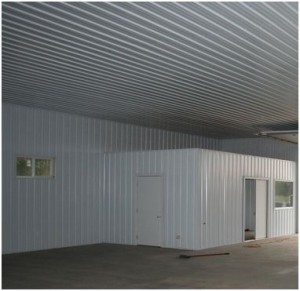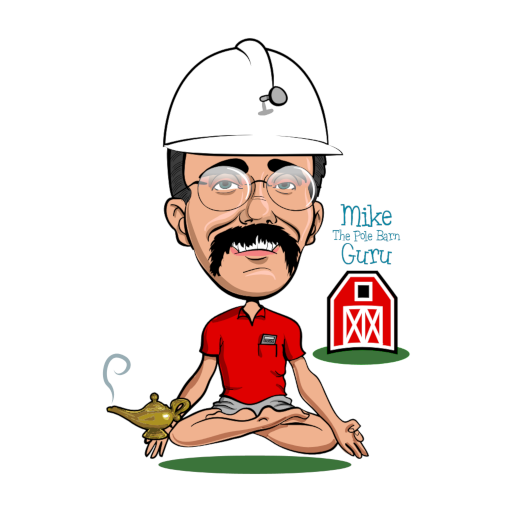In many parts of the country, a popular ceiling is to use steel liner panels. Generally the liner panels are the same rib configuration as steel roofing and siding, the difference being the panels themselves generally have little or no warranty on either the paint, or the steel themselves. As the paint is not exposed to the elements, this is really of no concern. These liner panels usually have a minimal coating of galvanization under the paint, so protection against rusting is low. Due to both of these factors, the cost of the material is lower than siding and roofing panels which require more protection from weather and sunlight deterioration.
In many cases, the steel liner panels are screwed directly to widely spaced trusses, sometimes spanning eight to 12 feet. This results in the liner panels having a noticeable sag between the trusses, especially if insulation is blown in on top of the panels.
 The common reasoning in using liner panels, as opposed to say… gypsum wallboard, is they are far lighter in weight, so the roof trusses do not need to carry as high of a load. Many people seem to feel the use of white painted liner panels, contributes to the building being brighter inside, when lights are turned on. Cost is also often mentioned as a factor, however properly installed liner panels, with framing close enough to minimize sagging, and drywalled systems are fairly close to the same price.
The common reasoning in using liner panels, as opposed to say… gypsum wallboard, is they are far lighter in weight, so the roof trusses do not need to carry as high of a load. Many people seem to feel the use of white painted liner panels, contributes to the building being brighter inside, when lights are turned on. Cost is also often mentioned as a factor, however properly installed liner panels, with framing close enough to minimize sagging, and drywalled systems are fairly close to the same price.
My own objection to steel liner panels is the noise factor. Drywall tends to absorb sound, where steel liner panels reflect it.
I also wondered if condensation on the underside of the panels could ever be a problem. Warm moist air inside the building rises, comes in contact with the ceiling liner panel steel (which will often be colder in fall, winter, spring than the inside the building) and condensation should occur. Having never owned a pole building with a steel liner, I couldn’t vouch for the actual situation personally.
Well, I got my answer today, from an online forum post:
“I think it depends on how tight your building is. My metal garage has two roll up doors and there is a gap at the top of them. In the winters, I had no problems with condensation on the metal ceiling until I sealed over the doors with OSB. I have insulation stuffed in all of the grooves on the inside at the edge of the metal roof. So, that made it pretty air tight. Now in the winters, when the roof has frost or snow on it, when the sun comes out, the metal ceiling will drip water on my car. I have to cover it with a plastic tarp to keep the water off of it.”
Personally, my idea of having things inside a building is to avoid having to break out the blue tarps! Considering a steel liner panel ceiling in a new pole building? I’d recommend thinking long and hard before you jump into this one.







